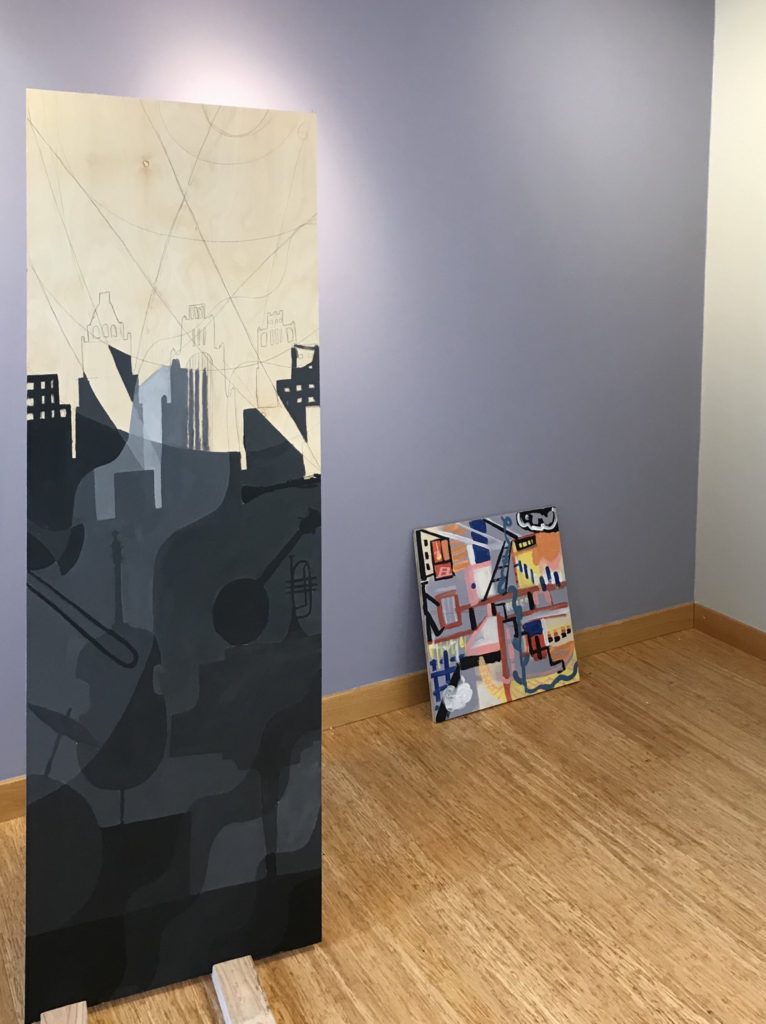Caden Collins ‘23 | Eshika Tangri ‘23

Photo courtesy of Twitter account @EArtteacher
Students walking on the second floor of the Crawford Campus Center may notice a constant flurry of student artists working in the gallery. The new showcase, created by the US Honors 2D Design III class, will serve as February’s gallery show. Upper School art teacher, David Sigel, explains, “Normally, we bring external artists to come and display their work, and then ask them to come into the classes and teach small workshops. This year we decided that we wanted to share the wealth and allow students to have a big, main show.”
The pieces are inspired by what the students are currently studying. Sigel says, “They’re learning about the Harlem Renaissance, from slavery to the northern migration, and Harlem’s role as a vibrant cultural center for African-Americans.” Describing the actual murals and how they will be displayed, Sigel says, “They’re really interesting – it’s going to be kind of an immersion mural where you’re going to be asked to walk in [the gallery], and the panels are going to be standing up throughout the room in a sort of serpentine formation. You’re going to walk in and see a black and white version of instruments and musicians on the fronts of the panels, and then as you come back on the other side, in order to represent the sound of the music, the backs of the panels will be more colorful and abstract.” He continues, “They are two feet by six feet. 17 panels for each student, and they each paint both sides.”
The time period was essential. As Sigel says, “Because it’s so rich in the culture of that crossover between the visual and performing arts, it was the perfect thing for our students to study.” Speaking on the research, Sigel elaborates, “We studied artists like Stuart Davis and Aaron Douglas, contemporary poets like Langston Hughes, as well as musicians like Louis Armstrong and Duke Ellington, so we really tried to find as many crossover points as possible.”
Sigel explains his thought process behind the showcase, saying, “The gallery show is a two-fold project – it’s an opportunity to let my honors level kids have an understanding of how they should start to think about displaying their work outside of a studio, how they should market themselves, and the planning that goes into an exhibit.” As a final touch, Sigel adds, “Mr. Erwin is always asking for ways to spruce up the choral room and some of the music practice rooms, so these pieces will be donated to the music department when we’re done.”
Some participating students expressed their enthusiasm for the novel project. Megan Hinckley ‘21 says, “Normally our projects are individual, while this one allows our different interpretations of the movement to join together into a cohesive gallery. Our pieces are tied together through a limited palette.” Mikel Zahralddin ‘21 adds, “Normally when we work, Mr. Sigel lets someone put on music or plays one of his playlists, but for this project he’s only played jazz, especially pieces from Harlem Renaissance artists, and he’s pushed for us to take more out of this music while we work. All of our pieces are distinctly individual, yet we decided to keep all our pallets the same to connect our exhibit into one story.”
The students have been working on the project for a while. Sigel elaborates, “We have been planning since the end of first semester. We’ve been really talking about it, they’ve had Canvas reading assignments, we’ve had discussions, we’ve had planning meetings, and we’ve talked to Susan Coote, who is our gallery coordinator. Now we wanted to have the execution happen in the gallery in plain sight so people can see the process.” Sigel comments, “We’re hoping it will be up for February, and instead of having an opening reception, we’re having a closing reception on February 20th, and everyone is invited. Mr. Dankanich and Mr. Finegan are going to have their orchestra and band students play, and we’re hoping to be able to work with the English department to have them read some poetry from the time. It really is a lot of cross-curricular layers going on.”
When asked what his favorite part of the project and the process involved with it, Sigel says, “For me, it’s the excitement that happens no matter how much you plan, that unknown that happens when the students take over the idea and take on the excitement of how it’s going to progress and how it’s going to happen. That’s the best thing a teacher could ever experience: to plan and make sure everything is on track, but to really empower the students to take the idea and run with it.”